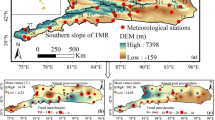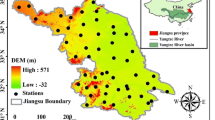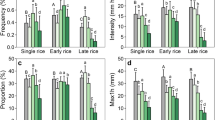Abstract
In this study, the regional variations of climate extremes and its possible impact on rice yield in Jiangsu province, southeast China were investigated. A total of 18 climate extremes indices (CEI) of rice-growing period (May–October) based on the daily climate records and rice yield data at 52 stations during 1961–2012 were calculated and analyzed. The main findings were as follows: (1) due to the remarked regional differences of climate extremes, Jiangsu could be divided into six climatic subregions: westernmost, northwest, north, southwest, south, and southeast corner; (2) trends of 18 indices in the six subregions using Mann–Kendall test indicated that Jiangsu was dominated by an obvious wetting and warming tendency, especially in the southern area; (3) correlation analysis between rice yield and CEI using first-difference and climate-induced yield method showed that the negative influences of precipitation extremes were more notable compared to temperature extremes; (4) P95 [precipitation due to very wet days (> 95th percentile)] should be selected as a key meteorological disasters indicator affecting rice yield in the northwest, north, southwest, and south Jiangsu; (5) the increase of P95 since 1990s was detected in most of Jiangsu, which would bring huge risks to rice growing.








Similar content being viewed by others
References
Ara I, Lewis M, Ostendorf B (2016) Spatio-temporal analysis of the impact of climate, cropping intensity and means of irrigation: an assessment on rice yield determinants in Bangladesh. Agric Food Secur 5(1):12
Arshad M, Amjath-Babu TS, Krupnik TJ et al (2017) Climate variability and yield risk in South Asia’s rice–wheat systems: emerging evidence from Pakistan. Paddy Water Environ 15:249
Atroosh KB, Mustafa AT (2012) An estimation of the probability distribution of Wadi Bana flow in the Abyan Delta of Yemen. J Agric Sci 4(6):80
Bao Y, Liu W, Gao P, Shen S (2012) Study on characteristics of rice heat damages in Jiangsu province under the background of climate warming and its influence on rice yield. Chin J Agrometeorol 33:289–296 (in Chinese with English abstract)
EI-Maayar M, Lange MA (2013) A methodology to infer crop yield response to climate variability and change using long-term observations. Atmosphere 4:365–382
Huang J, Zhan F, Xue Y, Li Q (2016a) Recent changes of extreme dryness/wetness pattern and its possible impact on rice productivity in Jiangsu province, southeast China. Nat Hazards. https://doi.org/10.1007/s11069-016-2529-0
Huang J, Chen X, Zhou L et al (2016b) Statistical analysis of the relationship between climate-induced maize yield and rainy-season precipitation across Inner Mongolia, North China. Theor Appl Climatol. https://doi.org/10.1007/s00704-016-1839-1
Huang J, Zhan F, Xue Y et al (2017) Recent changes of rice heat stress in Jiangxi province, southeast China. Int J Biometeorol 61(4):623–633
Kaufman L, Rousseeuw P (1990) Finding groups in data: an introduction to cluster analysis. Wiley Press, New York
Lee MH, Ho CH, Kim J et al (2012) Assessment of the changes in extreme vulnerability over East Asia due to global warming. Clim Change 113(2):301–321
Liu Y, Xiao J, Ju W et al (2016a) Recent trends in vegetation greenness in China significantly altered annual evapotranspiration and water yield. Environ Res Lett 11(9):094010
Liu B, Chen X, Chen J et al (2016b) Impacts of different threshold definition methods on analyzing temporal-spatial features of extreme precipitation in the Pearl River Basin. Stoch Environ Res Risk Assess. https://doi.org/10.1007/s00477-016-1284-9
Quan C, Jing YS, Tan KY (2013) Progress in research of impacts of climate change on yield of three major grain crops. Chin Agric Sci Bull 29(32):361–367 (in Chinese with English abstract)
Revadekar JV, Preethi B (2012) Statistical analysis of the relationship between summer monsoon precipitation extremes and foodgrain yield over India. Int J Climatol 32(3):419–429
Rummukainen M (2013) Climate change: changing means and changing extremes. Clim Change 121(1):3–13
Sawano S, Hasegawa T, Ishigooka Y et al (2015) Effects of nitrogen input and climate trends on provincial rice yields in China between 1961 and 2003: quantitative evaluation using a crop model. Paddy Water Environ 13:529
Shao QX, Campbell NA (2002) Modeling trends in groundwater levels by segmented regression with constraints. Aust N Z J Stat 44:129–141
Shi P, Wu M, Qu S et al (2015) Spatial distribution and temporal trends in precipitation concentration indices for the Southwest China. Water Resour Manag 29(11):3941–3955
Shuai J, Zhang Z, Liu X et al (2013) Increasing concentrations of aerosols offset the benefits of climate warming on rice yields during 1980–2008 in Jiangsu province, China. Reg Environ Change 13(2):287–297
Sönmez İ, Kömüşcü AÜ (2011) Reclassification of rainfall regions of Turkey by K-means methodology and their temporal variability in relation to North Atlantic Oscillation (NAO). Theor Appl Climatol 106(3–4):499–510
Sun S, Chen H, Ju W et al (2013) Effects of climate change on annual streamflow using climate elasticity in Poyang Lake Basin, China. Theor Appl Climatol 112(1–2):169–183
Sun SL, Sun G, Caldwell P et al (2015) Drought impacts on ecosystem functions of the U.S. National Forests and grasslands: part II assessment results and management implications. For Ecol Manag 353:269–279
Tao F, Yokozawa M, Liu J et al (2008) Climate-crop yield relationships at provincial scales in China and the impacts of recent climate trends. Clim Res 38(1):83–94
Wang XL, Feng Y (2013) RHtestsV4 user manual. Climate Research Division, ASTD
Wang Y, Zhou L (2005) Observed trends in extreme precipitation events in China during 1961–2001 and the associated changes in large-scale circulation. Geophys Res Lett 32(9):L09707
Wang D, He J, Qi L et al (2015) Temperature characteristics of Eurasia in autumn and winter and its cause under global warming mitigation. J Meteorol Sci 35(5):534–542 (in Chinese with English abstract)
Wang QX, Wang MB, Fan XH et al (2016) Trends of temperature and precipitation extremes in the Loess Plateau Region of China, 1961–2010. Theor Appl Climatol. https://doi.org/10.1007/s00704-016-1820-z
Wu Y, Zhou P, Zhang Y et al (2015) Integrated flood risk assessment and zonation method: a case study in Huaihe River basin, China. Nat Hazards 78:635–651
Xia L, Zhang Q, Ning Sun et al (2015) Climate change characteristics in Jiangsu province, 1960–2012. J Glaciol Geocryol 37(6):1480–1489 (in Chinese with English abstract)
Xiao H, Jiang AJ, Shen Z et al (2006) The space-time distribution characters of maximum diurnal precipitation in Jiangsu province and the statistic assimilation. Sci Meteorol Sin 26(2):177–182 (in Chinese with English abstract)
Yang L, Qin Z, Tu L (2015) Responses of rice yields in different rice-cropping systems to climate variables in the middle and lower reaches of the Yangtze River, China. Food Secur 7(5):951–963
You Q, Kang S, Aguilar E et al (2011) Changes in daily climate extremes in China and their connection to the large scale atmospheric circulation during 1961–2003. Clim Dyn 36:11–12
Acknowledgements
This paper was mainly supported by China Special Fund for Meteorological Research in the Public Interest (Major projects) (GYHY201506001-6), Jiangsu Province Science Fund for Excellent Young Scholars (BK20170102), Open Fund of Jiangsu Key Laboratory of Agricultural Meteorology/Nanjing University of Information Science and Technology (JKLAM1603, JKLAM1604), Natural Science Foundation of Jiangsu Higher Education Institutions of China (16KJB170008), Open Research Fund of Key Laboratory of Agrometeorological Support and Applied Technique/China Meteorological Administration (AMF201507, AMF201608).
Author information
Authors and Affiliations
Corresponding author
Rights and permissions
About this article
Cite this article
Huang, J., Zhang, F., Zhou, L. et al. Regional changes of climate extremes and its effect on rice yield in Jiangsu province, southeast China. Environ Earth Sci 77, 106 (2018). https://doi.org/10.1007/s12665-018-7295-8
Received:
Accepted:
Published:
DOI: https://doi.org/10.1007/s12665-018-7295-8




